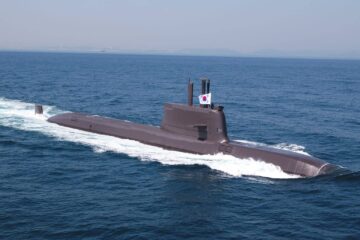The second SLBM test comes just seven months after the first last September.
On April 18th, two SLBMs were fired in succession within 20 seconds of one another, traveling over 400 km before splashing into the sea within a pre-designated target area. The new SLBM is based on South Korea’s Hyunmoo-2B, a land based ballistic missile that has a range of 500 km.
Analysts say that this is likely to be the last test before the missile reaches operational capability:
“The most recent launch follows in the footsteps of the first and was meant to evaluate the SLBM’s effectiveness under realistic deployment conditions,. This test will contribute significantly to strengthening our military capabilities, ensuring that the SLBM reaches operational capability without delay. Moreover, we plan on developing other advanced capabilities in order to maintain peace on the Korean peninsula.”
ROK military spokesperson
Once the KSS-III program is complete, the ROKN will be able to launch a total of 78 SLBMs, with the lighter Batch-I carrying 6 missiles per ship and the heavier Batch-II and Batch-III vessels carrying 10 each.
Unlike last September, neither the Blue House nor the military have attempted to publicize the most recent test. Some analysts point out that this one occurred amidst growing tension on the Korean peninsula, with North Korea firing a “new guided weapon” just two days prior, in addition to making preparations for resuming nuclear tests and for a large-scale military parade in recent weeks. Furthermore, the Combined Command Post Training, a joint military exercise between the U.S. and South Korea which has been criticized by North Korea in the past, began on the day of the launch. The deliberate attempt to keep a low-profile may have been aimed at preventing tensions from escalating any further.
About KSS-III Submarines

The first KSS-III Batch-I sub, ROKS Dosan Ahn Chang-ho, was commissioned into the ROKN on August 13th last year. Three KSS-III Batch-I submarines have been launched so far, with the last unit, ROKS Shin Chae-ho, scheduled for delivery in 2024. The ROKN plans to acquire another 3 Batch-II submarines, followed by 3 more Batch-III ships, for a total of 9 KSS-III submarines. The KSS-III, also called the Jang-Bogo-III or Dosan Ahn Changho-class, is the last phase of the KSS program, which, when finished, will see the ROKN acquire a total of 27 submarines.
The KSS-III, being built by Hyundai Heavy Industries (HHI) and Daewoo Shipbuilding & Marine Engineering (DSME) is the largest class of submarines in the ROKN. Displacement has grown with each phase of the KSS program; the KSS-I and KSS-II displaces 1,200 tons and 1,800 tons respectively when surfaced. The KSS-III submarines are twice as heavy with the Batch-I displacing over 3,300 tons surfaced, while the Batch-II displaces closer to 3,600 tons surfaced. KSS-III Batch-III ships are even heavier and will likely have a surface displacement of around 4,000 tons.

The KSS-III submarines will introduce new technologies to the ROKN. For example, the Batch-II will be the second submarine in the world to use lithium-ion (Li-ion) batteries, after the Soryu-class in service with the Japanese Maritime Self-Defense Force. The use of Li-ion batteries means that the ship will be able to remain submerged for longer, making it less vulnerable to anti-submarine platforms. It will also have a more advanced sonar and combat system than previous submarines.
According to DSME, 80% of the components in the Batch-II ships will be produced domestically, a significant increase compared to previous models. It is hoped that this will create jobs and make the ship more competitive in the export market. Some components, however, will be produced abroad, with Spain’s Indra and France’s ECA Group providing the signals intelligence system and steering consoles respectively.






